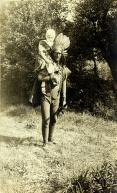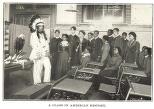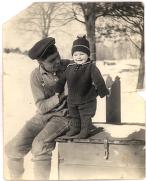|

Native Carrying Captive, Eunice Williams

Native Americans praying

"Learning By Doing At Hampton"

Jesse Bowman, Abenaki logger and basketmaker, with daughter Marion Flora Bowman
|
Summary and Objective
Students will understand that it isn't always possible to look at a person and know if they are Indian or not. Images of American Indians, reenactors, and non-Indian peoples are used to stimulate a discussion of the stereotypes we may have. Do we have a static image of what Native Americans look like? Do your students understand that Native Americans are still alive today?
Teaching Plan
Step 1.
Start with a brainstorming session to uncover what your students know about American Indians. Make a chart, "What I Believe To Be True About American Indians". Prompt the students during the discussion to uncover what they know about the foods, clothing, and homes used by present day American Indians.
Step 2.
Teachers: it is helpful for students to have hands-on access to images. Print all the images suggested for this lesson including the three that can be accessed from the websites listed. Be sure to print enough copies for small groups of students to work with. Show students the images attached to this activity. Have students work in small groups to decide which they believe to be an Indian and why. Students will need time to look closely and group the images according to their own cirteria. Have each group discuss what criteria were used to place an image in each grouping. After the discussion, show the images again and this time reveal to your students which are American Indians and which are not.
Step 3.
Have students adjust their original assumptions based on the class discussion.
Step 4.
Share literature with your students that show American Indians today. One source is the November 1994 issue of Cobblestone. Another great source is a series of books put out by Lerner Publishing Co. as part of a series, "We are Still Here: Native Americans Today" including: The Sacred Harvest: Ojibway Wild Rice Gathering, by Gordon Regguinti, and Clambake: A Wampanoag Tradition, by Russell M. Peters. These books show modern children and adults engaged in their daily lives and involved with carrying on the traditions of their unique heritage. Before reading these books ask the question, "Are these American Indians or not." It will be interesting to see if they say yes to one image of an individual and no to another image of that same individual in different dress.
Step 5.
Let a child dress up in headdress and hold a tomahawk and ask, "Now is this an American Indian?"
Step 6.
Optional:
Invite a community member with Indian heritage to your classroom to discuss their work, their family, and their home. After the speaker has been in the room and the students are comfortable, ask if they think this guest is an American Indian. Have the guest then share stories about their ancestors and any ceremonial dress or other objects of their choosing.
|




